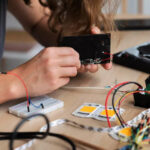
Consumers will soon get their hands on gadgets and gizmos that were beyond the realms of science fiction just a few decades ago.
We will have handheld molecular scanners — a fraction of the size of Mr Spock’s fictional tricorder — that tell you how many calories or how much sugar is in your food, talking appliances that call out repairers themselves, and robotic exoskeletons that help paraplegics walk.
Technological advances are moving faster than governments can keep up with them, entertainment is set to take a new step forward with virtual reality headsets, and scanners and sensors will soon be on most things we touch.
Car maker Audi said last week that its self-driving cars would be on sale in 2017, although experts warn that governments have not made them legal.
Looking at the road ahead … an Audi A7 sedan fitted with experimental automated driving technology.
Helping to drive the rapid surge of innovation is online crowd funding, where people can financially back entrepreneurs and their ideas quickly and easily.
Dan Bennett, the Australian managing director of global venture capital crowd funding business OurCrowd, said consumers’ knowledge of this new world depended on whether or not they were tech heads, but “it’s out there … it’s coming”.
Mr Bennett said crowd funding helped accelerate the advances. “It provides that support at an early stage when businesses really need it,” he said.
Dreams made possible … Derek Herrera, a paraplegic US Marine, stands upright using ReWalk, an exoskeleton using motors and braces for upright walking. Picture: Joanne Rathe/The Boston Globe via Getty Images Source: Getty Images
OurCrowd, which has a community of 8000 wealthy investors from 120 countries, this month helped Australian business Global Kinetics Corporation raise $1.5 million for its Parkinson’s disease treatment technology.
Andy Lark, the CEO of technology consultanting firm Group Lark and chief marketing officer of software company Xero, said we were moving to a world of sensors on everything we touch.
“Think about the doorbell as a connected device that photographs not just people pushing the button but also enabling you to remotely grant access, or every electrical device signalling failures,” he said.
“The sensor will dwarf the phone in terms of impact.”
Switch your reality … Start-up Vcemo is planning to operate a 360 virtual reality media streaming service for the Oculus Rift.
Mr Lark said technology was already driving changes to society that people barely recognised. He said the world’s biggest taxi company, Uber, had no cars and the world’s biggest accommodation provider, Airbnb, owned no real estate.
Big ideas were being developed faster and cheaper than ever, he said, adding that new iPhones with 128 gigabytes of memory were a good example.
“In 1995 one gig of memory was $9000, so if you think your phone’s expensive now, it could have been a lot more.
“What you are looking at is a collapse of the technology cost curve.”
This suggests that the hefty costs of new technologies, such as more than $70,000 for a self-driving cars or robotic exoskeletons, will drop dramatically over time.
SCiO, the first molecular sensor to fit in the palm of your hand, is expected to retail for a few hundred dollars when it launches in July this year.
[“source-news.com.au”]







